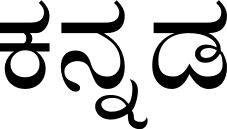Difference between revisions of "Language/Kannada/Grammar/Nouns"
m (Quick edit) |
m (Quick edit) |
||
| Line 103: | Line 103: | ||
{{Kannada-Page-Bottom}} | {{Kannada-Page-Bottom}} | ||
{{Kannada-0-to-A1-Course-TOC}} | |||
[[Category:Course]] | |||
[[Category:Kannada-Course]] | |||
[[Category:0-to-A1-Course]] | |||
[[Category:Kannada-0-to-A1-Course]] | |||
Revision as of 14:29, 17 March 2023
Hi Kannada learners! 😊
In this lesson, we will focus on the basics of Kannada nouns. Nouns are the building blocks of a sentence, and it is crucial to understand them to form grammatically correct sentences.
What are Nouns?
Nouns are words that represent people, places, things, animals, and ideas. In Kannada, nouns can be categorized into three types based on gender: masculine, feminine, and neuter.
Masculine Nouns
Masculine Nouns are words that represent males or masculine objects. Some examples of masculine nouns in Kannada are:
| Kannada | Pronunciation | English |
|---|---|---|
| ಅಣ್ಣ | aṇṇa | elder brother |
| ವೃತ್ತ | vṛtta | circle |
| ಗರ್ಭಿಣಿ | garbhiṇi | pregnant woman |
Feminine Nouns
Feminine Nouns are words that represent females or feminine objects. Some examples of feminine nouns in Kannada are:
| Kannada | Pronunciation | English |
|---|---|---|
| ಸೋದರಿ | sōdari | sister |
| ಗಿಡ | giḍa | plant |
| ಕೊಳಲು | koḷalu | cuckoo bird |
Neuter Nouns
Neuter Nouns are words that do not have a gender associated with them. Some examples of neuter nouns in Kannada are:
| Kannada | Pronunciation | English |
|---|---|---|
| ಮರ | mara | tree |
| ಕಡುಬು | kaḍubu | dumpling |
| ಗಾಳಿ | gāḷi | wind |
Plural Nouns
Plural Nouns are words that represent more than one person, place or thing. In Kannada, plural nouns can be formed by adding the suffix '-ಗಳು' (-gaḷu) or '-ಗಳಿ' (-gaḷi) to the end of the singular noun. The choice between '-ಗಳು' (-gaḷu) or '-ಗಳಿ' (-gaḷi) depends on the ending sound of the noun. For example:
| Singular | Plural |
|---|---|
| ಪೆನ್ | ಪೆನ್ಗಳು (pen + gaḷu) / ಪೆನ್ಗಳಿ (pen + gaḷi) |
| ಹುಲಿ | ಹುಲಿಗಳು (huli + gaḷu) / ಹುಲಿಗಳಿ (huli + gaḷi) |
Dialogue
- Person 1: ನನ್ನ ನೆರಳು ಓಡುತ್ತಿದೆ. (Nanna neraLu ōḍuttide.) (My shadow is running.)
- Person 2: ನೀವು ನನಗೆ ನೆರಳನ್ನು ತೋರಿಸಿದರೆ ನಾನು ಈಗ ಹೇಗಿದ್ದೇನೆಂದು ನೋಡಬಹುದು. (Nīvu nanage neraLannu tōrisidare nānu īga hēgididdenḍu nōḍabahudu.) (If you show me my shadow, I can see how I am currently doing.)
Tips and Tricks
To improve your Kannada Grammar, you can also use the Polyglot Club website. Find native speakers and ask them any questions!
Sources
- Nouns: Naming Words in kannada, part -1,Noun english grammar ...
- Kannada grammar - Wikipedia
- Parts of Speech Part 1 - Noun | Explained in kannada for kids ...
Videos
Grammar - Concept - Common vs proper nouns (Kannada) - YouTube
Related Lessons
- Adjectives
- Pronouns
- How to Use Be
- Negation
- Future Tense
- Gender
- Give your Opinion
- Questions
- Conditional Mood
